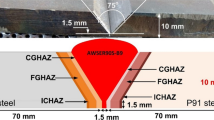Abstract
This work attempts to investigate the effect of flux activation on mechanical and metallurgical properties of modified 9Cr–1Mo steel during activated TIG (A-TIG) welding. Composition-based oxide flux MnO2 was identified to produce a 6-mm-thick square-groove butt weld joint in P91 steel plates considering the satisfactory bead penetration during “bead-on-plate” experiment. During the experiment, it was found that using MnO2, the process of “A-TIG” can increase the penetration of the joint and depth-to-width ratio (D/W) of the weld for welding P91 steel up to 231% and 0.93 respectively. The base metal and the multipass GTA weld joint’s mechanical properties have been compared with the modified 9Cr–1Mo steel A-TIG weld joint. To study other metallurgical aspects of the TIG and A-TIG process, tests such as microhardness, tensile, bend, impact test and chemical analysis were performed. Optical microscopy was used to conduct the characterization of microstructure.













Similar content being viewed by others
References
Howse D, Developments in A-TIG Welding; Exploiting Advances in Arc Welding Technology, Woodhead Publishing, p 3.
Anderson P C J, and Harvey M D F, A review of techniques to manage penetration variability during TIG welding.
Merchant S Y, Int J Res Eng Technol 04 (2015) 574, ISSN 2319-1163.
Arivazhagan B, Kamaraj M, Albert S K, and Sundaresan S, Comparison of FCAW, SMAW and GTAW for Joining Modified 9Cr–1Mo Steel, IGCAR, Kalpakkam.
Li X, Cabrillat M T, and Lejeail Y, Study of Modified 9Cr–lMo Welds, p 64.
Tseng K H, and Chuang K J, Powder Technol 228 (2012) 36.
Ruckert G, Perry N, Sire S, and Marya S, Enhanced Weld Penetrations in GTA Welding with Active Fluxes Case Studies: Plain Carbon & Stainless Steels, Titanium and Aluminium, Science Arts & Metiers (SAM).
Saha P K, Tube Pipe J (2003).
Tripathy I, Effect of Microstructure on Sliding Wear Behaviour of Modified 9Cr–1Mo Steel. M. Tech thesis, National Institute of Technology, Rourkela, Odisha (2011).
Goswami P, in Proceedings from the Sixth International Conference, August 31–September 3, Santa Fe, New Mexico, USA (2010) p 768.
API Technical Report 938-B, Use of 9Cr–1Mo-V (Grade 91) Steel in the Oil Refinery Industry, 1st edn (2008).
Welding “Grade 91” Alloy Steel, Sperko Engineering Services, Inc. (2007) p 1.
Arivazhagan B, Kamaraj M, Albert S K, and Sundaresan S, Comparison of FCAW, SMAW and GTAW for Joining Modified 9Cr–1Mo Steel, IGCAR, Kalpakkam.
Kumar S, Awasthi R, Viswanadham C S, Bhanumurthy K, and Dey G K, Mater Des 59 (2014) 211, http://dx.doi.org/10.1016/j.matdes.2014.02.046.
Howse D, in Presented at International Conference on ‘Exploiting Advances in Arc Welding Technology’, Cambridge, UK, 30–31 March (1998).
Snow H M (Marie), Investigation of the Effect of a Surface Active Flux on the Microstructure and Properties of Gas Tungsten Arc Welds Made on a Superaustenitic Stainless Steel. Theses and Dissertations (2002).
Li D J, Lu S P, Li D Z, and Li Y Y, Sci Technol Weld Join 15 (2010) 528.
Tungsten Electrode Guidebook, Guidebook for the Proper Selection and Preparation of Tungsten Electrodes for Arc Welding, Diamond Group products, https://www.diamondground.com/tungsten-guidebook/.
Singh K, Reddy G J, Vidyasagar D V, and Thyagarajan V, in ECCC Creep Conference, 12–14 September, London (2005).
Welding consumables for P91 steels for the power generation industry, Metrode Welding Consumables (2009) p 1.
P92 Welding consumables for the power generation industry, Metrode Welding Consumables (2009) p 1.
Henry J F, Comb Cycle J (2005).
Hussain M, and Khalil M S, in International Conference on Space 2014 (ICS 2014), 12–14 November 2014, Islamabad, Pakistan, Space & Upper Atmosphere Research Commission (SUPARCO) (2014).
Zhang Z, Marshall A M, and Farrar J C M, in Conference Proceedings—International Conference on Integrity of High-Temperature Welds, Nottingham (1998) p 77.
Tseng K H, Powder Technol 233 (2013) 72.
AWS A5.28, Specification for Low-Alloy Steel Electrodes and Rods for Gas Shielded Arc Welding (identical to ASME SFA-5.28).
Benscoter A O, in ASM Handbook, vol. 9, 9th edn, OH: ASM (1985) p 165.
ASME Boiler and Pressure Vessel Code Section V Nondestructive Examination, The American Society of Mechanical Engineers, 2013 Edition.
ASME Boiler and Pressure Vessel Code Section VIII Division 1, Rules for Construction of Pressure Vessels, The American Society of Mechanical Engineers, 2013 Edition.
A 387/A 387 M–06a Standard Specification for Pressure Vessel Plates, Alloy Steel, Chromium-Molybdenum, ASTM International.
ASME Boiler and Pressure Vessel Code Section IX, Welding, brazing, and fusing qualifications—Qualification standard for welding, brazing, and fusing procedures; Welders; brazers; and welding, brazing, and fusing operators, The American Society of Mechanical Engineers (2013).
Magudeeswaran G, Nair S, Sundar L, and Harikannan N, Optimization of Process Parameters of the Activated Tungsten Inert Gas Welding for Aspect Ratio of UNS S32205.
Vidyarthy R S, Dwivedi D K, and Vasudevan M, J Mater.
Vasudevan M, J Mater Eng Perform 26 (2017) 1325, http://dx.doi.org/10.1007/s11665-017-2517-x.
Gregory N, TWI Bull (1999) 1.
Zubairuddin M, Albert S K, Chaudhari V, and Suri V K, Proc Mater Sci 5 (2014) 832, https://doi.org/10.1007/s12206-014-1132-0.
Acknowledgement
I am grateful to the staffs of Pandit Deendayal Petroleum University, Gandhinagar, who equipped me with a podium to conduct the experimental work which was required for the investigation and Board for Research in Fusion Science and Technology (BRFST), Institute for Plasma Research (IPR), Gandhinagar, for sponsoring the research project via project number NFP-08/MAT/01. The project is funded by The Institution of Engineers (India), 8 Gokhale Road, Kolkata 700020, under R&D Grant-in-Aid scheme, Project ID: DR2016003.
Author information
Authors and Affiliations
Corresponding author
Additional information
Publisher's Note
Springer Nature remains neutral with regard to jurisdictional claims in published maps and institutional affiliations.
Rights and permissions
About this article
Cite this article
Dhandha, K.H., Badheka, V.J. Comparison of Mechanical and Metallurgical Properties of Modified 9Cr–1Mo Steel for Conventional TIG and A-TIG Welds. Trans Indian Inst Met 72, 1809–1821 (2019). https://doi.org/10.1007/s12666-019-01657-5
Received:
Accepted:
Published:
Issue Date:
DOI: https://doi.org/10.1007/s12666-019-01657-5




